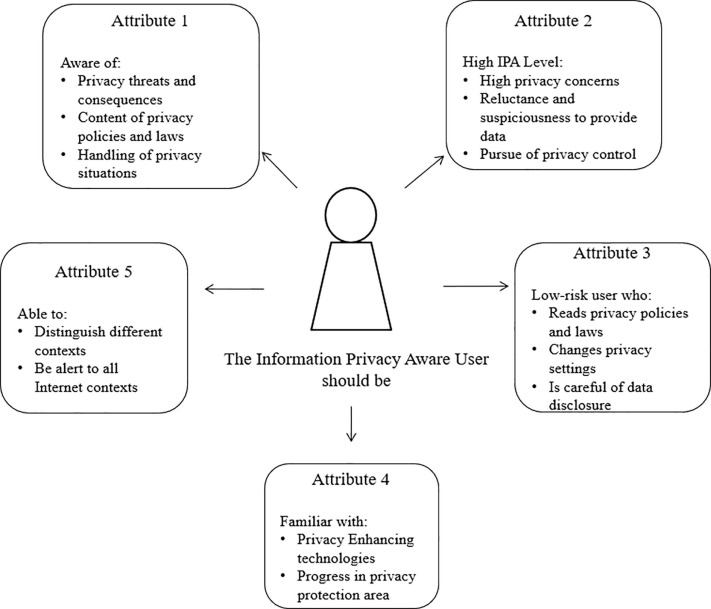Privacy is important in the modern digital environment. Online users must be mindful of the potential risks and take precautions to safeguard privacy as different entities, such as service providers and other organizations that collect and may exploit personal information. So, users should generally be interested in maintaining their privacy.
However, despite realizing the importance of privacy-preserving behavior, users’ online behavior does not always coincide with their attitude, a phenomenon known as the privacy paradox [1].

(Note: IPA: Information Privacy Awareness)
This paradox points to two things: users need assistance to act in line with their attitudes, and there is a lack of understanding of user attitudes and behavior [3], which is problematic for both users and organizations.
There is no typical user with consistent privacy requirements, so a one-size-fits-all approach may not be sufficient. One possible solution is creating privacy personas for the users to understand their cognitive, affective, sensory, and behavioral attributes to improve the situation.
Algorithmically-generated personas have several advantages relative to other methods of creating personas and have been used extensively in marketing and media domains [4]. The personas approach is affected by the complexity of the process, a disconnect between users’ needs and persona, and focuses only on the mainstream users [5].
In the privacy domain, some researchers have used the personas approach to understand users’ privacy needs and goals (for example, [6-10]) with quantitative and qualitative data collected through surveys and interviews. However, apart from the limitations of the type of users and limited attributes to select for creating users’ privacy personas, the methodologies used produce static personas that do not fulfill the organizational needs.
Survey2Persona (S2P) supports businesses and organizations in generating dynamic survey-driven privacy personas accurately and rapidly with no required statistics – the interface is point-and-click. Once data is fed to the S2P system, S2P lets the user select the attributes of interest and create privacy personas to help the organization and service providers understand their users’ privacy needs, attitudes, and behaviors.
Reference:
1. Kokolakis, S. (2017). Privacy attitudes and privacy behaviour: A review of current research on the privacy paradox phenomenon. Computers & security, 64, 122-134.
2. Soumelidou, A., & Tsohou, A. (2021). Towards the creation of a profile of the information privacy aware user through a systematic literature review of information
privacy awareness. Telematics and Informatics, 61, 101592.
3. Farooq, A., Jeske, D., & Isoaho, J. (2019). Predicting students’ security behavior using information-motivation-behavioral skills model. In ICT Systems Security and Privacy Protection: 34th IFIP TC 11 International Conference, SEC 2019, Lisbon, Portugal, June 25-27, 2019, Proceedings 34 (pp. 238-252). Springer International Publishing.
4. Jansen, B. J., Salminen, J. O., & Jung, S. G. (2020). Data-driven personas for enhanced user understanding: Combining empathy with rationality for better insights to analytics. Data and Information Management, 4(1), 1-17.
5. Jansen, B., Salminen, J., Jung, S.g., & Guan, K. (2021). Data-Driven Personas. Springer International Publishing.
6. Morton, A., & Sasse, M. A. (2014, July). Desperately seeking assurances: Segmenting users by their information-seeking preferences. In 2014 Twelfth Annual International Conference on Privacy, Security and Trust (pp.102-111). IEEE.
7. Dupree, J. L., Devries, R., Berry, D. M., & Lank, E. (2016, May).Privacy personas: Clustering users via attitudes and behaviors toward security practices. In Proceedings of the 2016 CHI Conference on Human Factors in Computing Systems (pp. 5228-5239).
8. Elueze, I., & Quan-Haase, A. (2018). Privacy attitudes and concerns in the digital lives of older adults: Westin’s privacy attitude typology revisited. American Behavioral Scientist, 62(10), 1372-1391.
9. Schomakers, E. M., Lidynia, C., & Ziefle, M. (2019). A typology of online privacy personalities: Exploring and segmenting users’ diverse privacy attitudes and behaviors. Journal of Grid Computing, 17, 727-747.
10.Biselli, T., Steinbrink, E., Herbert, F., Schmidbauer-Wolf, G. M., & Reuter, C. (2022). On the Challenges of Developing a Concise Questionnaire to Identify Privacy Personas. Proceedings on Privacy Enhancing Technologies, 4, 645-669.
Tags: Dynamic PersonasPersonasPrivacyPrivacy Paradoxsurvey2persona

